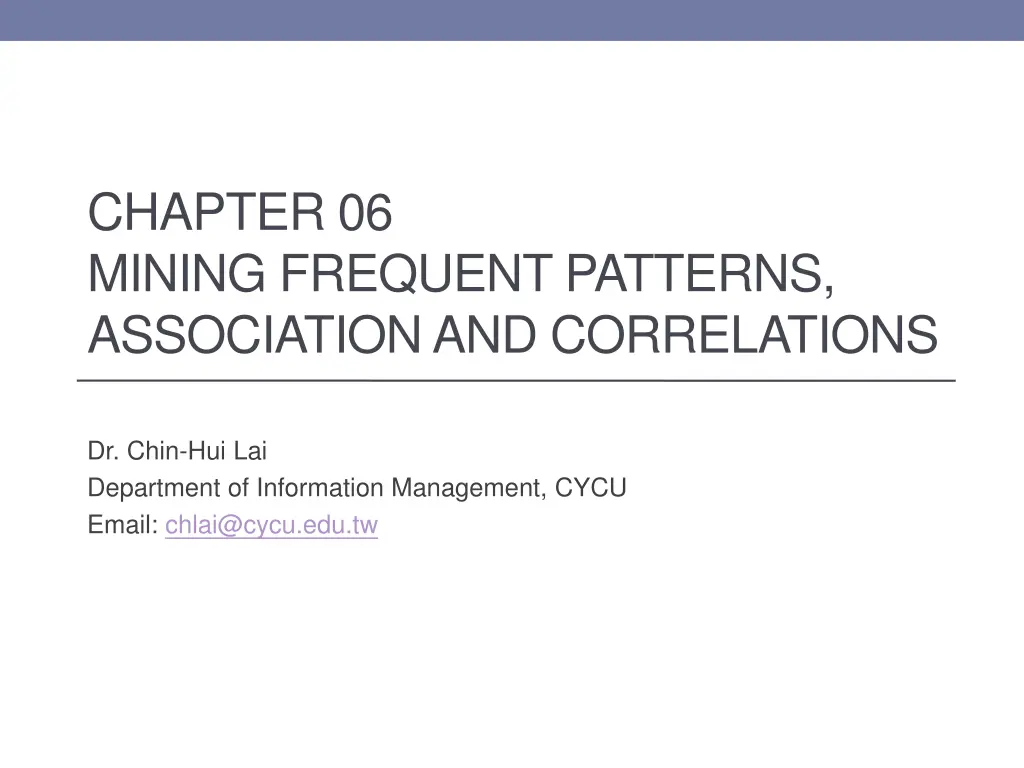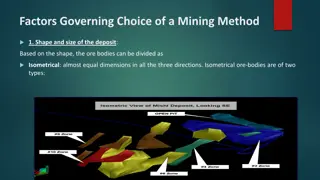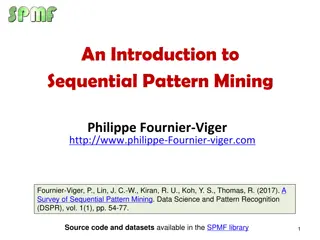
Mining Frequent Patterns and Associations
Explore the importance of frequent pattern analysis in data mining, covering concepts, methods like Apriori and FP-growth algorithms, and applications like market basket analysis. Discover why mining frequent patterns is essential for tasks such as association, correlation, and classification analysis across various data types.
Download Presentation

Please find below an Image/Link to download the presentation.
The content on the website is provided AS IS for your information and personal use only. It may not be sold, licensed, or shared on other websites without obtaining consent from the author. If you encounter any issues during the download, it is possible that the publisher has removed the file from their server.
You are allowed to download the files provided on this website for personal or commercial use, subject to the condition that they are used lawfully. All files are the property of their respective owners.
The content on the website is provided AS IS for your information and personal use only. It may not be sold, licensed, or shared on other websites without obtaining consent from the author.
E N D
Presentation Transcript
CHAPTER 06 MINING FREQUENT PATTERNS, ASSOCIATION AND CORRELATIONS Dr. Chin-Hui Lai Department of Information Management, CYCU Email: chlai@cycu.edu.tw
Outline Basic Concepts Frequent Itemset Mining Methods Apriori algorithm FP-growth algorithm Which Patterns Are Interesting? Pattern Evaluation Methods Summary
What Is Frequent Pattern Analysis? Frequent pattern: a pattern (a set of items, subsequences, substructures, etc.) that occurs frequently in a data set First proposed by Agrawal, Imielinski, and Swami [AIS93] in the context of frequent itemsets and association rule mining Motivation: Finding inherent regularities in data What products were often purchased together? Beer and diapers?! What are the subsequent purchases after buying a PC? What kinds of DNA are sensitive to this new drug? Can we automatically classify web documents? Applications Basket data analysis, cross-marketing, catalog design, sale campaign analysis, Web log (click stream) analysis, and DNA sequence analysis.
Example: Market Basket Analysis Figure 6.1 Market basket analysis.
Why Is Freq. Pattern Mining Important? Freq. pattern: An intrinsic and important property of datasets Foundation for many essential data mining tasks Association, correlation, and causality analysis Sequential, structural (e.g., sub-graph) patterns Pattern analysis in spatiotemporal, multimedia, time-series, and stream data Classification: discriminative, frequent pattern analysis Cluster analysis: frequent pattern-based clustering Data warehousing: iceberg cube and cube-gradient Semantic data compression: fascicles Broad applications
Basic Concepts: Frequent Patterns itemset: A set of one or more items k-itemset X = {x1, , xk} (absolute) support, or, support count of X: Frequency or occurrence of an itemset X (relative) support, s, is the fraction of transactions that contains X (i.e., the probability that a transaction contains X) An itemset X is frequent if X s support is no less than a minsup threshold TID Items bought 10 Beer, Nuts, Diaper 20 Beer, Coffee, Diaper 30 Beer, Diaper, Eggs 40 50 Nuts, Eggs, Milk Nuts, Coffee, Diaper, Eggs, Milk Customer buys both Customer buys diaper Customer buys beer
Basic Concepts: Association Rules (1/2) TID Items bought Find all the rules X Y with minimum support and confidence support, s, probability that a transaction contains X Y 10 Beer, Nuts, Diaper 20 Beer, Coffee, Diaper 30 Beer, Diaper, Eggs 40 50 Nuts, Eggs, Milk Nuts, Coffee, Diaper, Eggs, Milk ??????? ? ? = ?(? ?) Customer buys both Customer buys diaper confidence, c, conditional probability that a transaction having X also contains Y Customer buys beer ?????????? ? ? = ? ? ? =???????(? ?) ???????(?)
Basic Concepts: Association Rules (2/2) Let minsup = 50%, minconf = 50% Freq. Pat.: Beer:3, Nuts:3, Diaper:4, Eggs:3, {Beer, Diaper}:3 Association rules: (many more!) Beer Diaper (60%, 100%) Diaper Beer (60%, 75%)
The Downward Closure Property and Scalable Mining Methods The downward closure property of frequent patterns Any subset of a frequent itemset must be frequent If {beer, diaper, nuts} is frequent, so is {beer, diaper} i.e., every transaction having {beer, diaper, nuts} also contains {beer, diaper} Scalable mining methods: Three major approaches Apriori (Agrawal & Srikant@VLDB 94) Freq. pattern growth (FPgrowth Han, Pei & Yin @SIGMOD 00) Vertical data format approach (Charm Zaki & Hsiao @SDM 02)
Apriori: A Candidate Generation & Test Approach Apriori pruning principle: If there is any itemset which is infrequent, its superset should not be generated/tested! (Agrawal & Srikant @VLDB 94, Mannila, et al. @ KDD 94) Method: 1) Initially, scan DB once to get frequent 1-itemset 2) Generate length (k+1) candidate itemsets from length k frequent itemsets 3) Test the candidates against DB 4) Terminate when no frequent or candidate set can be generated
The AprioriAlgorithmAn Example Database TDB Tid 10 20 30 A, B, C, E 40 Supmin= 2 Itemset {A} {B} {C} {D} {E} sup 2 3 3 1 3 Itemset {A} {B} {C} {E} sup 2 3 3 3 C1 Items A, C, D B, C, E L1 1stscan B, E Itemset {A, B} {A, C} {A, E} {B, C} {B, E} {C, E} sup 1 2 1 2 3 2 Itemset {A, B} {A, C} {A, E} {B, C} {B, E} {C, E} C2 Itemset {A, C} {B, C} {B, E} {C, E} sup 2 2 3 2 C2 L2 2ndscan L3 Itemset {B, C, E} sup 2 Itemset {B, C, E} C3 3rdscan
The AprioriAlgorithm (Pseudo-Code) Ck: Candidate itemset of size k Lk: frequent itemset of size k L1= {frequent items}; for (k = 1; Lk!= ; k++) do begin Ck+1= candidates generated from Lk; for each transaction t in database do increment the count of all candidates in Ck+1that are contained in t Lk+1= candidates in Ck+1with min_support end return kLk;
Implementation of Apriori How to generate candidates? Step 1: self-joining Lk Step 2: pruning Example of Candidate-generation L3={abc, abd, acd, ace, bcd} Self-joining: L3*L3 abcd from abc and abd acde from acd and ace Pruning: acde is removed because ade is not in L3 C4 = {abcd}
Further Improvement of the Apriori Method Major computational challenges Multiple scans of transaction database Huge number of candidates Tedious workload of support counting for candidates Improving Apriori: general ideas Reduce passes of transaction database scans Shrink number of candidates Facilitate support counting of candidates
Partition: Scan Database Only Twice Any itemset that is potentially frequent in DB must be frequent in at least one of the partitions of DB Scan 1: partition database and find local frequent patterns Scan 2: consolidate global frequent patterns (A. Savasere, E. Omiecinski and S. Navathe, VLDB 95) DB1 + DB2 + + DBk = DB sup1(i) < DB1 sup2(i) < DB2 supk(i) < DBk sup(i) < DB
DHP: Reduce the Number of Candidates A k-itemset whose corresponding hashing bucket count is below the threshold cannot be frequent count itemsets Candidates: a, b, c, d, e {ab, ad, ae} {bd, be, de} 35 88 Hash entries {ab, ad, ae} . . . {bd, be, de} . . . 102 {yz, qs, wt} Hash Table Frequent 1-itemset: a, b, d, e ab is not a candidate 2-itemset if the sum of count of {ab, ad, ae} is below support threshold (J. Park, M. Chen, and P. Yu. An effective hash-based algorithm for mining association rules. SIGMOD 95)
DHP: Reduce the Number of Candidates Min support count =3 Figure 6.5 Hash table, H2, for candidate 2-itemsets. This hash table was generated by scanning Table 6.1 s transactions while determining L1. If the minimum support count is, say, 3, then the itemsets in buckets 0, 1, 3, and 4 cannot be frequent and so they should not be included in C2.
Sampling for Frequent Patterns Select a sample of original database, mine frequent patterns within sample using Apriori Scan database once to verify frequent itemsets found in sample, only borders of closure of frequent patterns are checked Example: check abcd instead of ab, ac, , etc. Scan database again to find missed frequent patterns H. Toivonen. Sampling large databases for association rules. In VLDB 96
DIC: Reduce Number of Scans ABCD Once both A and D are determined frequent, the counting of AD begins Once all length-2 subsets of BCD are determined frequent, the counting of BCD begins ABC ABD ACD BCD AB AC BC AD BD CD Transactions 1-itemsets 2-itemsets B C D A Apriori {} Itemset lattice 1-itemsets 2-items S. Brin R. Motwani, J. Ullman, and S. Tsur. Dynamic itemset counting and implication rules for market basket data. SIGMOD 97 DIC 3-items
Exercise 1 Transactional database, D, for an AllElectronics Branch Please use the Apriori algorithm for finding the frequent itemsets in D. (The min support count =2)
Exercise 2 Based on the transactional database D for AllElectronics, the resulting association rules are as shown below. 1. Please calculate the confidence for each rule. 2. If the minimum confidence threshold is 70%, which are strong rules?
Pattern-Growth Approach: Mining Frequent Patterns Without Candidate Generation Bottlenecks of the Apriori approach Breadth-first (i.e., level-wise) search Candidate generation and test Often generates a huge number of candidates The FPGrowth Approach (J. Han, J. Pei, and Y. Yin, SIGMOD 00) Depth-first search Avoid explicit candidate generation Major philosophy: Grow long patterns from short ones using local frequent items only abc is a frequent pattern Get all transactions having abc , i.e., project DB on abc: DB|abc d is a local frequent item in DB|abc abcd is a frequent pattern
FP-Tree and FP-Growth Algorithm FP-Tree: Frequent Pattern Tree Compact presentation of the DB without information loss. Easy to traverse, can quickly find out patterns associated with a certain item. Well-ordered by item frequency FP-Growth Algorithm Start mining from length-1 patterns Recursively do the following Constructs its conditional FP-tree Concatenate patterns from conditional FP-tree with suffix Divide-and-Conquer mining technique Ref: https://www.softwaretestinghelp.com/fp-growth-algorithm-data-mining/
FP-Tree Definition (1/2) Three components: One root: labeled as null A set of item prefix subtrees A frequent-item header table root f : 4 c : 1 c : 3 b : 1 b : 1 Header Table item head of node-links f c a b m p a : 3 p : 1 m : 2 b : 1 p : 2 m : 1
FP-Tree Definition (2/2) Each node in the item prefix subtree consists of three fields: item-name node-link count Each entry in the frequent-item header table consists of two fields: item-name head of node-link
Construct FP-tree from a Transaction Database TID 100 200 300 400 500 Items bought {f, a, c, d, g, i, m, p} {a, b, c, f, l, m, o} {b, f, h, j, o, w} {b, c, k, s, p} {a, f, c, e, l, p, m, n} (ordered) frequent items {f, c, a, m, p} {f, c, a, b, m} {f, b} {c, b, p} {f, c, a, m, p} min_support = 3 {} 1. Scan DB once, find frequent 1-itemset (single item pattern) Header Table f:4 c:1 Item frequency head f 4 c 4 a 3 b 3 m 3 p 3 F-list = f-c-a-b-m-p 2. Sort frequent items in frequency descending order, f-list c:3 b:1 b:1 a:3 p:1 3. Scan DB again, construct FP-tree m:2 b:1 p:2 m:1
Example 1: FP-Tree Construction The transaction database used: TID Items Bought 100 200 300 400 500 f,a,c,d,g,i,m,p a,b,c,f,l,m,o b,f,h,j,o b,c,k,s,p a,f,c,e,l,p,m,n minimum support threshold = 3
Example 1 (cont.) First Scan: //count and sort count the frequencies of each item collect length-1 frequent items, then sort them in support descending order into L, frequent item list. L = {(f:4), (c:4), (a:3), (b:3), (m:3), (p:3)} Item frequency f 4 c 4 a 3 b 3 m 3 p 3 TID Items Bought (Ordered) Frequent Items 100 200 300 400 500 f,a,c,d,g,i,m,p a,b,c,f,l,m,o b,f,h,j,o b,c,k,s,p a,f,c,e,l,p,m,n f,c,a,m,p f,c,a,b,m f,b c,b,p f,c,a,m,p
Example 1 (cont.) Second Scan://create the tree and header table create the root, label it as null for each transaction Trans, do select and sort the frequent items in Trans increase nodes count or create new nodes If prefix nodes already exist, increase their counts by 1; If no prefix nodes, create it and set count to 1. build the item header table nodes with the same item-name are linked in sequence via node-links
Example 1 (cont.) The building process of the tree root root root root f : 1 f : 2 f : 3 c : 1 c : 2 c : 2 b : 1 a : 1 a : 2 a : 2 m : 1 m : 1 b : 1 m : 1 b : 1 p : 1 p : 1 m : 1 p : 1 m : 1 Create root After trans 1 (f,c,a,m,p) After trans 2 (f,c,a,b,m) After trans 3 (f,b)
Example 1 (cont.) The building process of the tree (cont.) root root f : 3 f : 4 c : 1 c : 1 c : 2 b : 1 c : 3 b : 1 b : 1 b : 1 a : 2 p : 1 a : 3 p : 1 m : 1 b : 1 m : 2 b : 1 p : 1 m : 1 p : 2 m : 1 After trans 4 (c,b,p) After trans 5 (f,c,a,m,p)
Example 1 (cont.) Build the item header table root f : 4 c : 1 c : 3 b : 1 b : 1 Header Table item head of node-links f c a b m p a : 3 p : 1 m : 2 b : 1 p : 2 m : 1
FP-Growth Algorithm Functionality: Mining frequent patterns using FP-Tree generated before Input: FP-tree constructed earlier minimum support threshold Output: The complete set of frequent patterns Main algorithm: Call FP-growth(FP-tree, null)
Partition Patterns and Databases Frequent patterns can be partitioned into subsets according to f-list F-list = f-c-a-b-m-p Patterns containing p Patterns having m but no p Patterns having c but no a nor b, m, p Pattern f Completeness and non-redundency
Find Patterns Having P From P-conditional Database Starting at the frequent item header table in the FP-tree Traverse the FP-tree by following the link of each frequent item p Accumulate all of transformed prefix paths of item p to form p s conditional pattern base {} Conditional pattern bases item cond. pattern base c f:3 a fc:3 b fca:1, f:1, c:1 m fca:2, fcab:1 p fcam:2, cb:1 Header Table f:4 c:1 Item frequency head f 4 c 4 a 3 b 3 m 3 p 3 c:3 b:1 b:1 a:3 p:1 m:2 b:1 p:2 m:1
Example 2: Mining Frequent Patterns using FP-Tree Start from the bottom of the header table: node p Two paths p s conditional pattern base {(f:2, c:2, a:2, m:2), (c:1, b:1)} p s conditional FP-tree Only one branch (c:3) pattern (cp:3) Patterns: (p:3) (cp:3) c a b m p transformed prefix path root f : 4 c : 1 c : 3 b : 1 b : 1 Header Table item head of node-links f a : 3 p : 1 m : 2 b : 1 p : 2 m : 1
Example 2 (cont.) Continue with node m Two paths m s conditional pattern base {(f:2, c:2, a:2), (f:1,c:1, a:1, b:1)} m s conditional FP-tree: (f:3, c:3, a:3) Call mine(<f:3, c:3, a:3>| m) Patterns: (m:3) see next slide root f : 4 c : 1 c : 3 b : 1 b : 1 Header Table item head of node-links f c a b m p a : 3 p : 1 m : 2 b : 1 p : 2 m : 1
mine(<(f:3, c:3, a:3>| m) root node a: (am:3) call mine(<f:3, c:3>|am) (cam:3) call(<f:3)|cam) (fcam:3) (fam:3) node c: (cm:3) call mine(<f:3>|cm) (fcm:3) node f: (fm:3) All the patterns: (m:3, am:3, cm:3, fm:3, cam:3, fam:3, fcm:3, fcam:3) Conclusion: A single path FP-Tree can be mined by outputting all the combination of the items in the path. Header Table item head of node-links f c a f : 3 c : 3 a : 3 conditional FP-tree of m
Example 2 (cont.) Continue with node b Three paths b s conditional pattern base {(f:1, c:1, a:1), (f:1), (c:1)} b s conditional FP-tree Patterns: (b:3) root f : 4 c : 1 c : 3 b : 1 b : 1 Header Table item head of node-links f c a b m p a : 3 p : 1 m : 2 b : 1 p : 2 m : 1
Example 2 (cont.) Continue with node a One path a s conditional pattern base {(f:3, c:3)} a s conditional FP-tree {(f:3, c:3)} Patterns: (a:3) (ca:3) (fa:3) (fca:3) root f : 4 c : 1 c : 3 b : 1 b : 1 Header Table item head of node-links f c a b m p a : 3 p : 1 m : 2 b : 1 p : 2 m : 1
Example 2 (cont.) Continue with node c Two paths c s conditional pattern base {(f:3)} c s conditional FP-tree {(f:3)} Patterns: (c:4) (fc:3) root f : 4 c : 1 c : 3 b : 1 b : 1 Header Table item head of node-links f c a b m p a : 3 p : 1 m : 2 b : 1 p : 2 m : 1
Example 2 (cont.) Continue with node f One path f s conditional pattern base f s conditional FP-tree Patterns: (f:4) root f : 4 c : 1 c : 3 b : 1 b : 1 Header Table item head of node-links f c a b m p a : 3 p : 1 m : 2 b : 1 p : 2 m : 1
Example 2 (cont.) Final results: item conditional pattern base {(f:2, c:2, a:2, m:2), (c:1, b:1)} conditional FP- tree {(c:3)}| p frequent patterns p {cp:3} m {(f:2, c:2, a:2), (f:1,c:1, a:1, b:1)} {(f:3, c:3, a:3)}| m {am:3}, {cm:3}, {fm:3}, {cam:3}, {fam:3}, {fcm:3}, {fcam:3} b {(f:1, c:1, a:1), (f:1), (c:1)} a {(f;3, c:3)} {(f:3, c:3}| a {ca:3},{fa:3},{fca:3} c {(f:3)} {(f:3)}| c {fc:3} f
A Special Case: Single Prefix Path in FP-tree Suppose a (conditional) FP-tree T has a shared single prefix-path P Mining can be decomposed into two parts Reduction of the single prefix path into one node {} Concatenation of the mining results of the two parts a1:n1 a2:n2 a3:n3 r1 {} a1:n1 C1:k1 + b1:m1 r1 = C1:k1 b1:m1 a2:n2 C2:k2 C3:k3 C2:k2 C3:k3 a3:n3
Benefits of the FP-tree Structure Completeness Preserve complete information for frequent pattern mining Never break a long pattern of any transaction Compactness Reduce irrelevant info infrequent items are gone Items in frequency descending order: the more frequently occurring, the more likely to be shared Never be larger than the original database (not count node-links and the count field)
The Frequent Pattern Growth Mining Method Idea: Frequent pattern growth Recursively grow frequent patterns by pattern and database partition Method 1) For each frequent item, construct its conditional pattern- base, and then its conditional FP-tree 2) Repeat the process on each newly created conditional FP-tree 3) Until the resulting FP-tree is empty, or it contains only one path single path will generate all the combinations of its sub-paths, each of which is a frequent pattern
Performance of FP-growth in Large Datasets 100 140 D2 FP-growth D2 TreeProjection D1 FP-growth runtime 90 120 D1 Apriori runtime 80 70 100 Runtime (sec.) Run time(sec.) 60 80 Data set T25I20D10K Data set T25I20D100K 50 60 40 40 30 20 20 10 0 0 0 0.5 1 1.5 2 0 0.5 1 Support threshold(%) 1.5 2 2.5 3 Support threshold (%) FP-Growth vs. Apriori FP-Growth vs. Tree-Projection






















